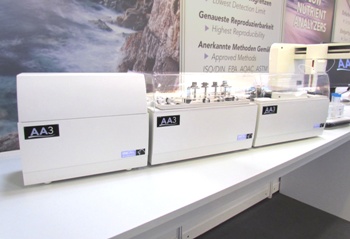Business is booming in the UK for SEAL Analytical, the manufacturer of the AA3HR and QuAAtro automated segmented flowlaboratory analyzers. Explaining the recent upturn in business, EMEA Sales Manager Haydon Warner says: “Automated testing of large numbers of samples at very low levels of analysis has been the main driver.
 Automated segmented flowlaboratory analyzers
Automated segmented flowlaboratory analyzers
Our team of application chemists and engineers are constantly developing innovative new features for both hardware and software, so laboratories are obviously keen to take advantage of the latest developmentswhen buying new or replacement equipment.”
Many of the recent orders have been placed by academic and research institutions and Haydon says: “A high proportion of the new orders have come from laboratories that test marine water, which is an application in which SEAL has a very strong reputation.”
The growth in demand for seawater analysis is being driven by a needfor very low level analysis ofthe inorganic nutrients; nitrate, nitrite, silicate and phosphate. Haydon says: “These nutrients are important for the growth of phytoplankton, which is a major component of the biological carbon pump;a mechanism for removing atmospheric CO2. Theanalysis of these nutrients underpins scientific research into the factors affecting phytoplankton communities in the oceans.”
Many of the recent orders have been for the AA3 HR instrument, which is the latest generation of the original Technicon™AutoAnalyzer II. Importantly, this instrument can be equipped with vibration-free LED light sources, which is essential for on-ship laboratory use.
The AA3HR operates at 60 to 70 samples per hour – these high analysis rates,combined with low reagent consumption, are achieved with segmented flow; a procedure in which air bubbles are introducedat regular intervals forming unique reaction segments that are mixed using glasscoils before passing througha chemistry manifold to a high resolution digital photometer.
In addition to seawater,SEAL Analytical autoanalyzers are also employed for the analysis of surface waters, wastewater, drinking water, fertilizer, plant materials, tobacco, beverages, food and animal feeds.